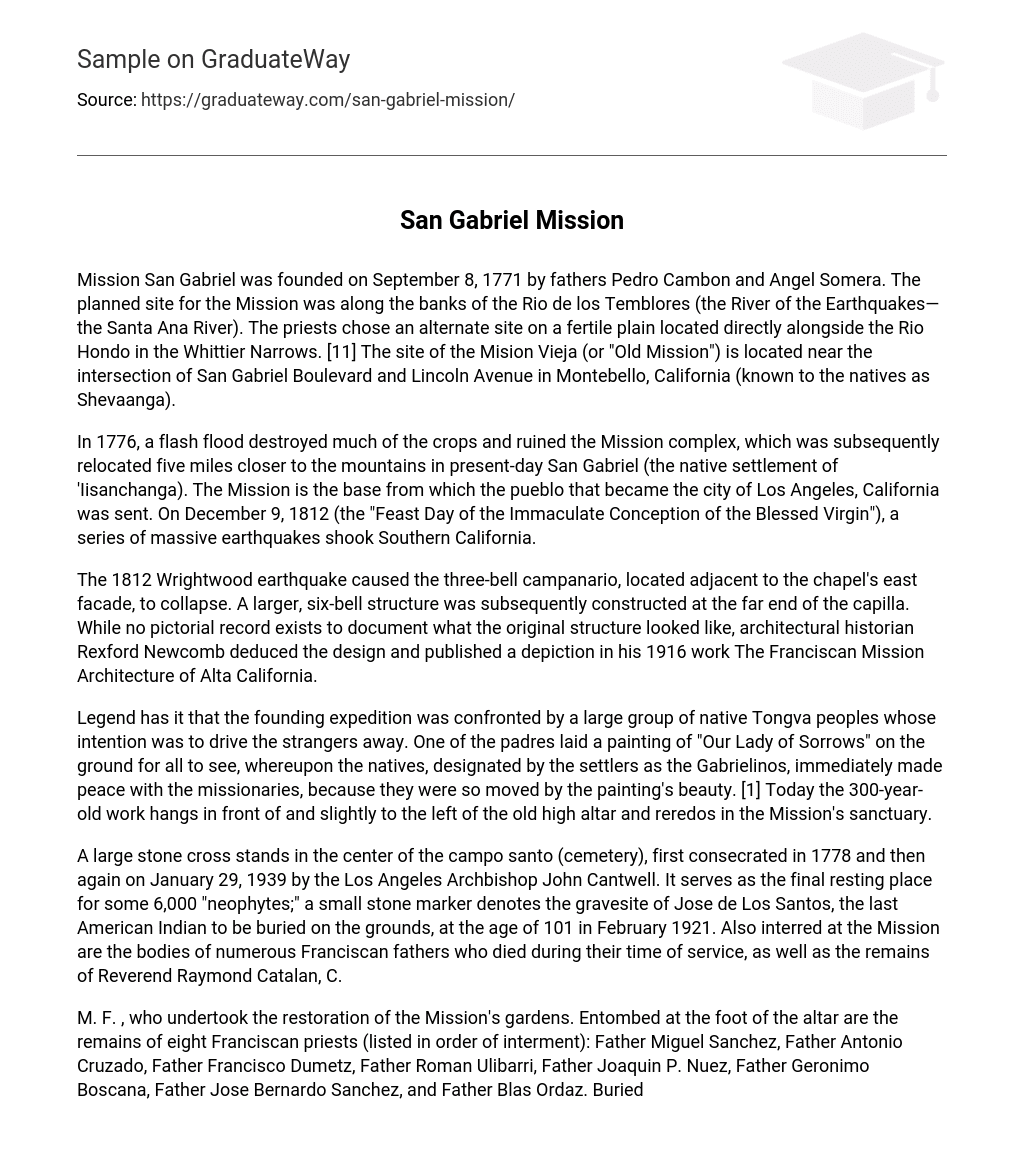Mission San Gabriel was founded on September 8, 1771 by fathers Pedro Cambon and Angel Somera. The planned site for the Mission was along the banks of the Rio de los Temblores (the River of the Earthquakes—the Santa Ana River). The priests chose an alternate site on a fertile plain located directly alongside the Rio Hondo in the Whittier Narrows. [11] The site of the Mision Vieja (or “Old Mission”) is located near the intersection of San Gabriel Boulevard and Lincoln Avenue in Montebello, California (known to the natives as Shevaanga).
In 1776, a flash flood destroyed much of the crops and ruined the Mission complex, which was subsequently relocated five miles closer to the mountains in present-day San Gabriel (the native settlement of ‘Iisanchanga). The Mission is the base from which the pueblo that became the city of Los Angeles, California was sent. On December 9, 1812 (the “Feast Day of the Immaculate Conception of the Blessed Virgin”), a series of massive earthquakes shook Southern California.
The 1812 Wrightwood earthquake caused the three-bell campanario, located adjacent to the chapel’s east facade, to collapse. A larger, six-bell structure was subsequently constructed at the far end of the capilla. While no pictorial record exists to document what the original structure looked like, architectural historian Rexford Newcomb deduced the design and published a depiction in his 1916 work The Franciscan Mission Architecture of Alta California.
Legend has it that the founding expedition was confronted by a large group of native Tongva peoples whose intention was to drive the strangers away. One of the padres laid a painting of “Our Lady of Sorrows” on the ground for all to see, whereupon the natives, designated by the settlers as the Gabrielinos, immediately made peace with the missionaries, because they were so moved by the painting’s beauty. [1] Today the 300-year-old work hangs in front of and slightly to the left of the old high altar and reredos in the Mission’s sanctuary.
A large stone cross stands in the center of the campo santo (cemetery), first consecrated in 1778 and then again on January 29, 1939 by the Los Angeles Archbishop John Cantwell. It serves as the final resting place for some 6,000 “neophytes;” a small stone marker denotes the gravesite of Jose de Los Santos, the last American Indian to be buried on the grounds, at the age of 101 in February 1921. Also interred at the Mission are the bodies of numerous Franciscan fathers who died during their time of service, as well as the remains of Reverend Raymond Catalan, C.
M. F. , who undertook the restoration of the Mission’s gardens. Entombed at the foot of the altar are the remains of eight Franciscan priests (listed in order of interment): Father Miguel Sanchez, Father Antonio Cruzado, Father Francisco Dumetz, Father Roman Ulibarri, Father Joaquin P. Nuez, Father Geronimo Boscana, Father Jose Bernardo Sanchez, and Father Blas Ordaz. Buried among the padres is centenarian Eulalia Perez de Guillen Marine, the “keeper of the keys” under Spanish rule; her grave is marked by a bench dedicated in her memory.
Mission San Gabriel Arcangel circa 1900. The trail in the foreground is part of the original El Camino Real. Well over 25,000 baptisms were conducted at San Gabriel between 1771 and 1834, making it the most prolific in the mission chain. In its heyday it furnished food and supplies to settlements and other missions throughout California. A majority of the Mission structures fell into ruins after it was secularized in November 1834. The





